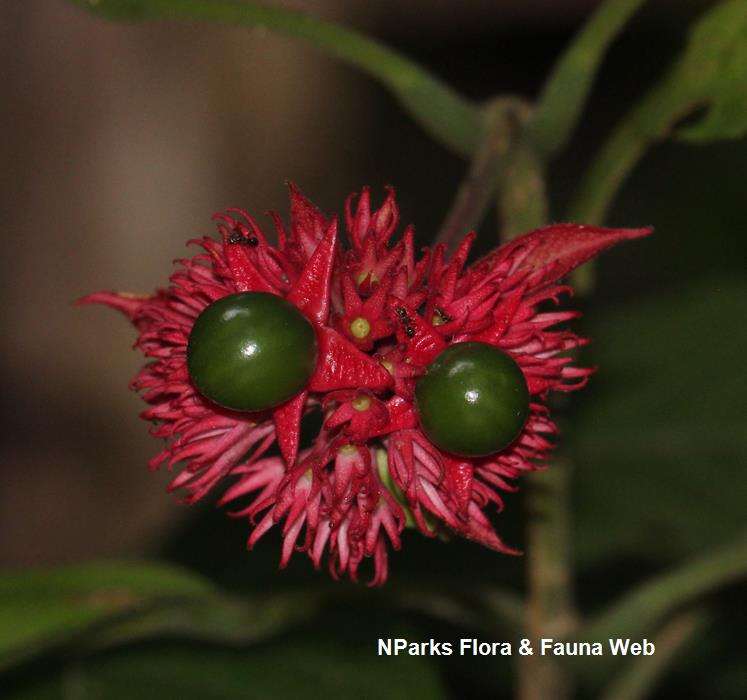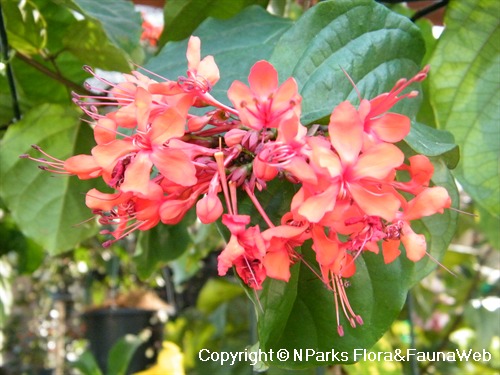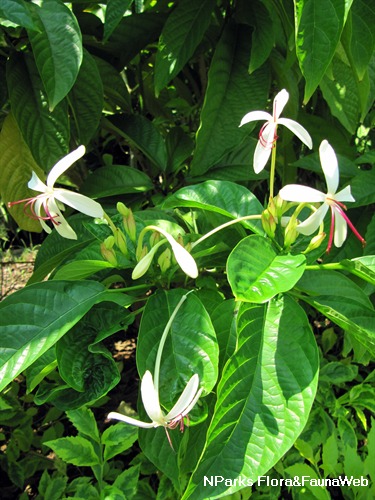.jpg)
Back
Clerodendrum deflexum Wall.
| Family Name: | Lamiaceae (Labiatae) |
| Common Name: | Nodding Witch's Tongue, Setawar Bukit, Balong Ayam, Kayu Sampu, Kayu Sampu Kelau, Lemak Berok, Lidah Kerbau, Lidah Kerbau Betina, Setawar Hutan, Sumbong Hutan |
Name
Classifications and Characteristics
| Plant Division | Angiosperms (Flowering Seed Plants) (Dicotyledon) |
|---|---|
| Plant Growth Form | Shrub |
| Lifespan (in Singapore) | Perennial |
| Mode of Nutrition | Autotrophic |
| Plant Shape | Irregular |
| Maximum Height | 1 m |
Biogeography
| Native Distribution | Malaya, Singapore, Sumatra, Thailand, and Vietnam. |
|---|---|
| Native Habitat | Terrestrial (Primary Rainforest, Mountain, Secondary Rainforest, Freshwater Swamp Forest) |
| Preferred Climate Zone | Tropical |
| Local Conservation Status | Native to Singapore (Least Concern (LC)) |
Description and Ethnobotany
| Growth Form | It is a shrub up to 1 m tall. Its branches are often inhabited by ants. |
|---|---|
| Foliage | Its opposite, stalked leaves have membranous leaf blades that are usually elliptic to drop-shaped with a pointed tip, and 15–41 by 5-15 cm. |
| Flowers | Its flowers are yellowish-white, tubular, 2 by 1 cm, and arranged in clusters with red bracts. |
| Fruit | Its fruit is round, purplish-black, pulpy, and contains 1 pear-shaped seed. |
| Habitat | It grows in inland, lowland and montane forests up to 1300 m altitude. |
| Associated Fauna | Its flowers are insect-pollinated. Its fruits are eaten by birds. |
| Cultivation | It can be propagated by seed. |
| Etymology | The genus epithet Clerodendrum is from the Greek word "kleros" which means chance and "dendron" meaning a tree. The species epithet deflexum means bent sharply backwards or deflexed, with reference to the flower. |
| Ethnobotanical Uses | Medicinal: The root extract is used by the Malay for fever and bowel-related complaints. |
Landscaping Features
| Landscaping | It is suitable for parks. |
|---|---|
| Desirable Plant Features | Ornamental Flowers |
| Landscape Uses | Parks & Gardens |
Fauna, Pollination and Dispersal
| Fauna Pollination Dispersal Associated Fauna | Bird-Attracting |
|---|---|
| Pollination Method(s) | Biotic (Fauna) |
| Seed or Spore Dispersal | Biotic (Fauna) |
Plant Care and Propagation
| Light Preference | Semi-Shade |
|---|---|
| Water Preference | Moderate Water |
| Rootzone Tolerance | Moist Soils, Well-Drained Soils, Fertile Loamy Soils |
| Propagation Method | Seed |
Foliar
| Foliage Retention | Evergreen |
|---|---|
| Mature Foliage Colour(s) | Green |
| Foliar Type | Simple / Unifoliate |
| Foliar Arrangement Along Stem | Opposite |
| Foliar Attachment to Stem | Petiolate |
| Foliar Shape(s) | Non-Palm Foliage (Obovate, Elliptical) |
| Foliar Venation | Pinnate / Net |
| Foliar Margin | Entire |
| Leaf Area Index (LAI) for Green Plot Ratio | 4.5 (Shrub & Groundcover - Dicot) |
Floral (Angiosperm)
| Flower & Plant Sexuality | Bisexual Flowers |
| Flower Colour(s) | White, Cream / Off-White |
|---|---|
| Flower Grouping | Cluster / Inflorescence |
| Flower Location | Axillary |
| Flower Symmetry | Radial |
| Individual Flower Shape | Tubular |
Fruit, Seed and Spore
| Mature Fruit Colour(s) | Black, Purple |
|---|---|
| Fruit Classification | Simple Fruit |
| Fruit Type | Fleshy Fruit , Non-Accessory Fruit |
Image Repository
Others
| Master ID | 525 |
|---|---|
| Species ID | 1821 |
| Flora Disclaimer | The information in this website has been compiled from reliable sources, such as reference works on medicinal plants. It is not a substitute for medical advice or treatment and NParks does not purport to provide any medical advice. Readers should always consult his/her physician before using or consuming a plant for medicinal purposes. |

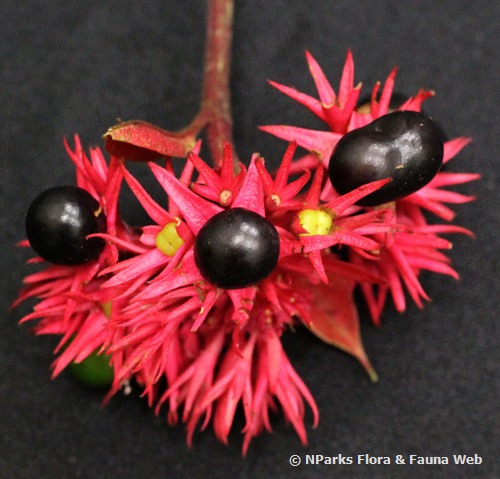
.jpg)
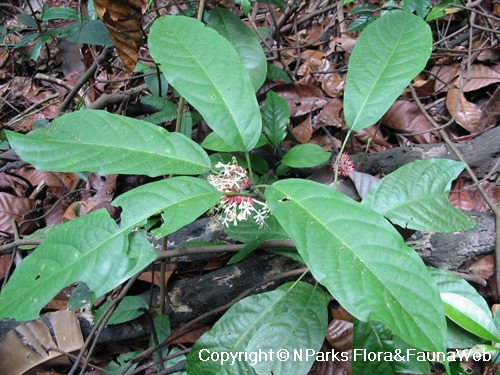
.jpg)
.jpg)
.jpg)
